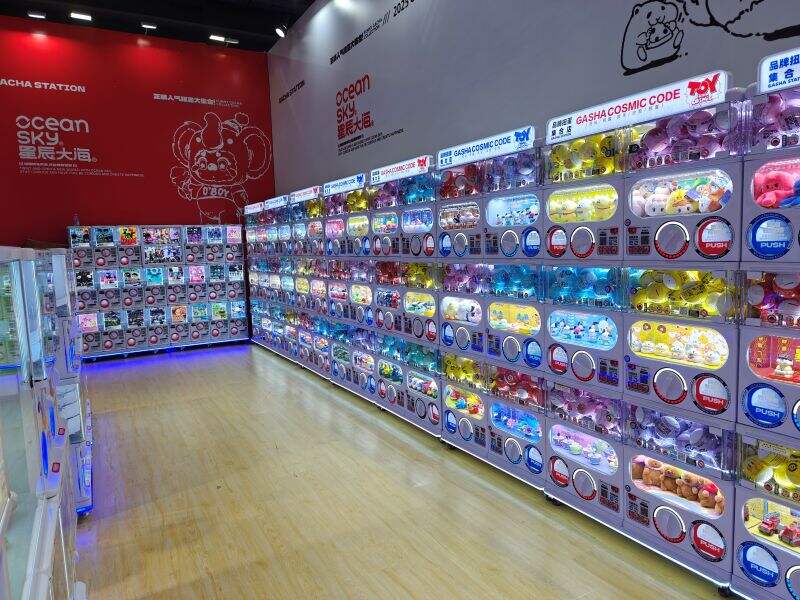Comprendre les Types de Machines à Gashapon et leurs Mécanismes Essentiels
Qu'est-ce qu'une Machine à Gashapon et Comment Fonctionne-t-elle ?
Ces petits distributeurs de capsules ont connu leur premier succès au Japon dans les années soixante. Les machines Gashapon fonctionnent comme des distributeurs automatiques classiques, mais au lieu de vendre des snacks, elles délivrent de minuscules capsules en plastique contenant des jouets surprises ou des objets de collection. Les gens insèrent des pièces, tournent la manivelle, puis attendent avec impatience que leur capsule tombe, renfermant le trésor chanceux qui les attend à l'intérieur. Même si les modèles plus récents disposent désormais d'écrans lumineux et d'options de paiement sans contact, ce qui les rend si addictifs n'a absolument pas changé : la joie pure de ne pas savoir ce qu'on va obtenir avant de l'avoir réellement en main. Les entreprises japonaises ont vraiment lancé la machine dans les années soixante-dix, en proposant des objets de collection de qualité supérieure dont les collectionneurs se disputent encore aujourd'hui. Cette innovation s'est rapidement répandue dans le monde entier, apparaissant partout, des supérettes aux parcs d'attractions, où les enfants (et les adultes) ne peuvent s'empêcher de tourner une nouvelle fois la manivelle.
Modèles manuels, à pièces et à paiement électronique comparés
Les machines à gashapon se divisent en trois catégories de paiement :
- Modèles manuels : Nécessitent un remontage manuel et l'introduction d'une somme exacte en pièces (généralement 100 à 500 yens)
- Systèmes électroniques : Prendent en charge les cartes à puce, les codes QR ou les paiements via application pour des transactions sans friction
- Unités hybrides : Combinent fentes à pièces et lecteurs sans contact pour s'adapter à une clientèle diversifiée
Bien que les systèmes manuels dominent les environnements traditionnels, 74 % des exploitants déclarent réaliser un chiffre d'affaires supérieur avec les modèles électroniques grâce à un meilleur suivi des transactions (Enquête Arcade Retail 2023).
Tranches de prix (100-500 yens) et conception de l'interface utilisateur
Le prix est aligné sur la valeur du produit et les caractéristiques démographiques des clients :
- 100-200 yens : Achat impulsif comme des autocollants ou des mini-figurines
- 300-500 yens : Objets de collection premium tels que figurines sous licence
Les machines dans la fourchette 300-500 yens utilisent souvent des affichages animés et des illustrations thématiques pour justifier un prix plus élevé et améliorer l'engagement grâce au récit visuel.
Capacité des capsules et compatibilité en fonction du type de machine
Les dimensions des capsules déterminent directement le choix de la machine :
| Type de machine | Compatibilité taille des capsules | Capacité typique |
|---|---|---|
| Compact à un seul niveau | 1,5 à 2,5 pouces | 20-40 capsules |
| Commerciale grand format | 2,5 à 3,5 pouces | 70 à 200 capsules |
| Module sur toit | Diverses | Personnalisable |
Les machines dans la fourchette 300-500 yens utilisent souvent des affichages animés et des illustrations thématiques pour justifier un prix plus élevé et améliorer l'engagement grâce au récit visuel.
Les versions murales sont idéales pour les cafés disposant d'un espace limité ou pour les petits magasins souhaitant ajouter des éléments surprenants sans encombrement, tandis que les formats plus grands favorisent les achats impulsifs grâce à leur visibilité.
Fonctionnalités clés pour la vente au détail : Exigences de paiement et de machine
Évolution des pièces de monnaie vers le numérique : L'évolution du paysage des paiements
Les machines gashapon modernes offrent une variété de méthodes de paiement, largement supérieures aux anciens systèmes limités aux pièces de monnaie. Ces options incluent le support des cartes à puce, des codes QR et des paiements via application, permettant des transactions plus rapides et plus pratiques. Une enquête de 2023 sur le commerce en arcade a révélé que près de la moitié des clients préfèrent désormais les méthodes de paiement sans contact lors de leurs achats dans des lieux commerciaux fréquentés. Malgré les avancées technologiques, les fentes traditionnelles pour pièces de 100 à 500 yens restent importantes, répondant ainsi aux consommateurs qui n'utilisent pas les moyens de paiement numériques. L'introduction d'options de paiement sans contact a permis de réduire le temps de transaction de 40 %, rendant le processus plus rapide et diminuant les temps d'attente.
Intégration intelligente avec des fonctionnalités IoT pour une meilleure efficacité commerciale
Les fabricants leaders intègrent désormais des fonctionnalités IoT dans les machines à gashapon, offrant des caractéristiques telles que la surveillance en temps réel des niveaux d'inventaire des capsules avec des notifications déclenchées à 15 % de capacité, la surveillance de la température et de l'humidité de la machine afin d'éviter la dégradation des contenus, ainsi que la synchronisation avec une sélection de produits localisée. Cette intégration intelligente conduit à des décisions basées sur les données, améliorant l'efficacité et réduisant les temps d'arrêt de 37 % lors de l'utilisation de conceptions modulaires de réparation comparées aux conceptions traditionnelles à cadre soudé, plus sujettes aux pannes.
Garantir la Durabilité et une Maintenance Optimale
Dans les environnements commerciaux à fort trafic, les machines à capsules nécessitent une construction robuste, intégrant souvent des matériaux de qualité tels que l'acier inoxydable de grade 304 et des fonctionnalités anti-vandalisme, afin de faire face aux exigences liées à un usage intensif, avec des interventions d'entretien fréquentes, en particulier pour les unités installées dans des emplacements exposés comme les entrées et les sorties. Une étude distincte menée en 2024 a indiqué que les conceptions modulaires de réparation peuvent réduire les temps d'arrêt liés à l'entretien de 37 % par rapport aux modèles non modulaires.
Considérations relatives aux dimensions et à l'aménagement de l'espace
Exigences d'installation et agencement efficace
Lors de l'installation de machines à capsules, il est essentiel pour les détaillants de maximiser l'efficacité de l'espace. Les modèles standards nécessitent environ 45 à 60 cm de largeur et 60 à 75 cm d'espace d'accès à l'avant, avec une hauteur libre idéale de 75 à 90 cm pour permettre une interaction optimale avec l'utilisateur. Pour les espaces restreints, les modèles muraux offrent une profondeur réduite d'environ 50 % par rapport aux unités autonomes.
Choisir la bonne taille de machine : compacte ou à plusieurs niveaux selon l'espace disponible en magasin
Les machines compactes, à un seul niveau, dont la hauteur est inférieure à 24 pouces, sont idéales pour les petits magasins disposant d'un espace au sol limité mais situés dans des zones à fort trafic. Ces machines peuvent contenir entre 40 et 80 capsules, offrant ainsi une grande variété de produits à collectionner, tout en nécessitant peu d'espace. En revanche, les grands espaces de plus de 1 500 pieds carrés devraient envisager des systèmes à plusieurs niveaux, qui, bien qu'exigeant davantage d'espace au sol, permettent de regrouper une plus large sélection d'articles dans une seule zone centrale. De nombreux magasins japonais réussissent à optimiser leur espace en combinant des machines compactes, à un seul niveau, près des caisses, avec des unités plus grandes et à plusieurs niveaux ailleurs dans le magasin.
Placement stratégique pour maximiser la visibilité et l'engagement des clients
Emplacements idéaux : allées de caisse, entrées
Le positionnement des machines à gashapon dans des zones à fort trafic, comme près des caisses avec un flux de 6 000 visiteurs par jour, augmente les chances d'achats impulsifs. Les machines situées près des entrées ont un taux d'engagement 23 % plus élevé. Une installation stratégique équipée d'un éclairage à capteur de mouvement peut efficacement capter l'attention des clients qui passent.
Intégration avec des présentoirs thématiques et des produits de la pop culture
Les points de vente qui associent des machines à gashapon à des produits connexes, comme les mangas, en proposant des thèmes tels que l'animé, constatent une augmentation de 41 % des visites répétées des clients. De même, la mise en relation de ces machines avec des articles liés aux jeux vidéo entraîne une hausse du chiffre d'affaires de 34 %, tandis que des thèmes saisonniers, comme Halloween, peuvent générer un accroissement des revenus de 52 %. Les détaillants peuvent tirer parti de ces liens avec la culture populaire grâce à des machines personnalisées avec des personnages populaires et des mises à jour opportunes des produits.
Étude de cas : Différences de performance selon les types de détaillants
Un rapport sur le gashapon de 2024, analysant 120 magasins, a mis en évidence des conclusions importantes : les machines compactes fonctionnant uniquement avec des pièces dans les supérettes ont enregistré 1,2 transactions par minute pendant les heures de pointe du déjeuner, alors que les magasins d'anime ont généré en moyenne des revenus mensuels plus élevés, atteignant 740 000 yens grâce à des murs de gashapon multipacks, des paiements par code QR et des éditions limitées. Les magasins axés sur les otaku ont attiré davantage de clients fidèles grâce à leur marchandise thématique de niche et à leurs stratégies événementielles.
FAQ
Qu'est-ce qu'une machine à gashapon ?
Les machines à gashapon sont un type de distributeur automatique japonais qui délivrent des jouets surprises ou des objets de collection dans des capsules en plastique. Les utilisateurs insèrent des pièces et tournent une manivelle pour recevoir un article au hasard.
Comment fonctionnent les machines à gashapon ?
Les machines à gashapon fonctionnent lorsque les utilisateurs insèrent des pièces et tournent une poignée, après quoi une capsule contenant un jouet ou un objet de collection surprise tombe pour être récupérée par l'utilisateur.
Quels types d'options de paiement sont disponibles pour les machines à gashapon ?
Les machines Gashapon offrent plusieurs options de paiement : modèles manuels à pièces, systèmes électroniques prenant en charge les cartes à puce, les codes QR et les paiements via application, ainsi que des systèmes hybrides acceptant à la fois l'argent liquide et les paiements sans contact.
Quels sont les niveaux de prix typiques pour les machines Gashapon ?
Les prix varient généralement entre 100 et 500 yens, les articles moins chers étant souvent des achats impulsifs comme des autocollants, tandis que les capsules plus onéreuses contiennent des objets de collection premium ou sous licence.
Où sont les meilleurs emplacements pour installer des machines Gashapon dans un magasin de vente au détail ?
Les meilleurs emplacements pour installer des machines Gashapon dans un environnement commercial sont les zones à fort passage telles que les allées de caisse, les entrées de magasin et les zones animées. La présence de capteurs de mouvement et d'affichages thématiques peut encore accroître la visibilité et l'engagement.
Qui sont les publics cibles principaux pour les machines Gashapon ?
Les principales catégories démographiques utilisant les machines Gashapon incluent les passionnés d'anime, les touristes internationaux et les collectionneurs adultes de jouets en capsule.
Table des Matières
- Comprendre les Types de Machines à Gashapon et leurs Mécanismes Essentiels
- Fonctionnalités clés pour la vente au détail : Exigences de paiement et de machine
- Considérations relatives aux dimensions et à l'aménagement de l'espace
- Placement stratégique pour maximiser la visibilité et l'engagement des clients
-
FAQ
- Qu'est-ce qu'une machine à gashapon ?
- Comment fonctionnent les machines à gashapon ?
- Quels types d'options de paiement sont disponibles pour les machines à gashapon ?
- Quels sont les niveaux de prix typiques pour les machines Gashapon ?
- Où sont les meilleurs emplacements pour installer des machines Gashapon dans un magasin de vente au détail ?
- Qui sont les publics cibles principaux pour les machines Gashapon ?

 EN
EN
 AR
AR DA
DA NL
NL FI
FI FR
FR DE
DE EL
EL HI
HI IT
IT JA
JA KO
KO NO
NO PL
PL PT
PT RU
RU ES
ES SV
SV TL
TL IW
IW ID
ID VI
VI HU
HU TH
TH TR
TR MS
MS GA
GA LO
LO MY
MY